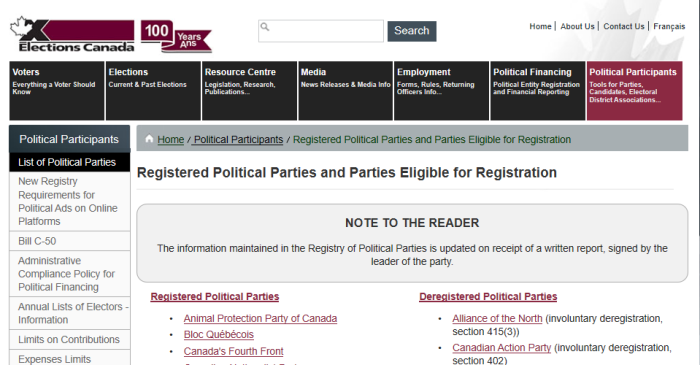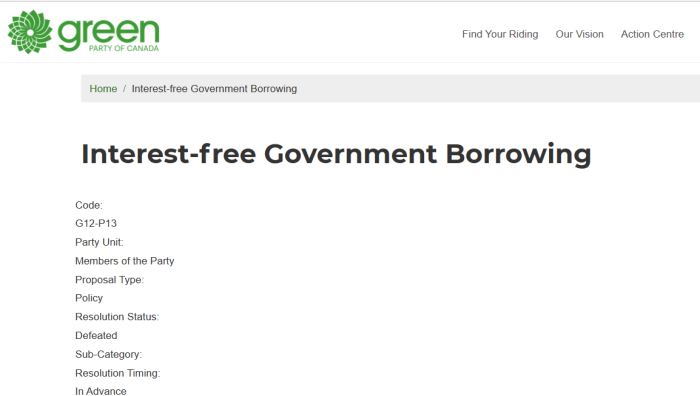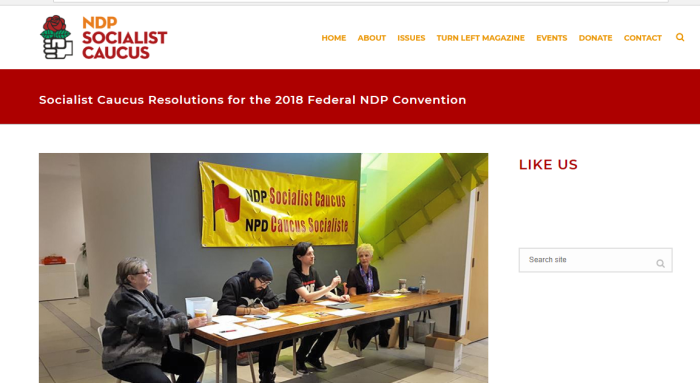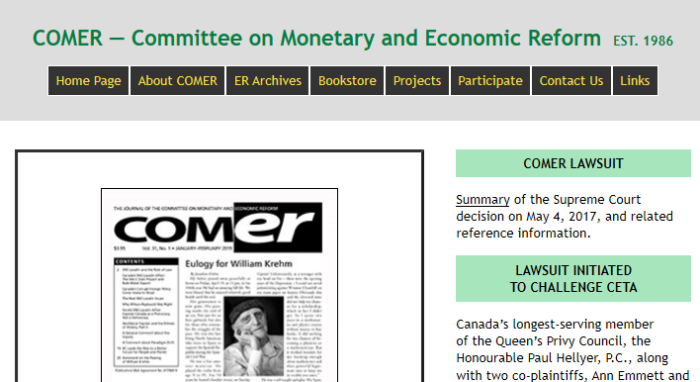(Political parties registered with Elections Canada)

Yeah…. this needs to be addressed.
The public is lied to constantly about the national debt in Canada. While media figures and politicians whine about “borrowing and overspending”, they intentionally leave a key piece out of the puzzle: the corruption of the monetary system.
In 1974, then Prime Minister Pierre Trudeau (without a mandate), stopped using the Bank of Canada to issue money and started using private banking loans. Money is still artificially created, but at least using the Bank of Canada meant that ownership of the debt remained in Canadian hands. There was no legitimate reason for doing so, yet it is rarely questioned in the media.
Instead of continually drawing attention to this change, politicians and media puppets focus on borrowing itself, not the usurious private loans. They focus on a much lesser issue.
This particularly true among “conservatives” and their parties. While many how about excessive borrowing and debt, few (if any), will discuss the changes to the banking system since 1974. By diverting attention away from the main issue, politicians distract the public, and act as a form of controlled opposition.
This is the current list of registered political parties, according to the Elections Canada website:
- Animal Protection Party of Canada
- Bloc Québécois
- Canada’s Fourth Front
- Canadian Nationalist Party
- Christian Heritage Party of Canada
- Communist Party of Canada
- Conservative Party of Canada
- Green Party of Canada
- Liberal Party of Canada
- Libertarian Party of Canada
- Marijuana Party
- Marxist-Leninist Party of Canada
- National Citizens Alliance of Canada
- New Democratic Party
- Parti pour l’Indépendance du Québec
- Parti Rhinocéros Party
- People’s Party of Canada
- Stop Climate Change
- The United Party of Canada
- Veterans Coalition Party of Canada
Note: this is not to endorse any one particular candidate or party. This research is just to see who is willing to address the topic of the Banking Cartel in an open and sincere manner.
1. Some Parties “Do” Address Banking Cartel
Before writing off all politicians and political parties as corrupt, it’s worth noting that some of them do address the corruption of the money system in their platforms. Let’s give credit where credit is due.
National Economic Plan
–Restore the Bank of Canada to its purpose as outlined in the Bank Act of 1938.
-Review and potentially repudiate debt incurred by our public institutions.
-Revise the Investment Canada Act so that foreign investment is prohibited in Class A Banks.
–Withdraw ourselves from organizations such as the Bank of International Settlements (BIS) and International Monetary Fund (IMF).
-Increase the reserve ratio of our banking sector from 0%.
-Establish state-owned trusts or funds (GLCs) in major sectors of the economy under a policy of corporatization.
Platform of the Canadian Nationalist Party.
BANK OF CANADA
(a) Canada currently borrows operating and investment capital from other nations and from international bankers and pays interest on the debt incurred—around $70 million every single day!
(b) The CHP would restore the Bank of Canada to its proper function. It would create and provide Canada’s money supply and provide low-interest or interest-free loans to Provinces, crown corporations and municipalities for urgently needed infrastructure.
(c) Current governments, through incorrect use of the Bank of Canada, have created a blight over the futures of our children as they will be forced to repay the debt plus interest.
Platform of the Christian Heritage Party.
Central Banking
Central banking is essentially legal counterfeiting that enriches a few at the expense of the many, increases wealth inequality, erodes buying power, constitutes a tax on the unborn, incentivizes consumption over production, leads to a harmful business cycle of booms and busts, creates market distortions and creates inefficient resource allocation. The Libertarian Party seeks to end the central banks monopoly on money supply and monetary policy and move back to a system of free banking.
Platform of the Libertarian Party of Canada.
Restore the 1934 Bank of Canada Act along with the 1938 Amendment and our own amendments, and thereby re-institute the true Bank of Canada, people’s bank, which fully belongs to the Canadian people, and thereby end the usury, inflation, and control of Canadians’ wealth by central banks.
Platform of National Citizens Alliance.
There may be other parties that have adopted similar policies. However, there are other parties who are clearly aware of the banking system, even if isn’t reflected in their current platforms.
2. Green Party BoC Motion in 2012

Party Commentary
If adopted, this motion will dramatically change the party’s fiscal policies by introducing the requirement that the federal government borrow from the Bank of Canada.
Preamble
-WHEREAS government debt is reaching such critical proportions that many countries are currently facing financial collapse because of the interest on the debts they owe to banks;
-WHEREAS Section 91 of Canada’s Constitution (classes 1A, 4, 14, 15, 18, 19 & 20) on the Legislative Authority of the Parliament of Canada stipulates that Parliament has full control of the public debt and interest, as well as the right to issue money;
-WHEREAS the interest on money borrowed by the government through the issue of treasury bills and bonds purchased by banks and foreign governments now accounts for about 90% of the total market debt of $596.8 billion (31 March 2011) owed by the people of Canada, and repaying that interest is advantageous to banks but deleterious to the welfare of the country;
-WHEREAS the Bank of Canada issues interest-free currency into circulation for the benefit of the nation, though this is currently only about 5% of the country’s money supply, under the authority of the Bank of Canada Act it is authorized to make interest-free loans to the Government of Canada to make up budget deficits and is currently doing so, by holding approximately $60 billion in Government of Canada bonds and treasury bills;
-WHEREAS the Bank of Canada currently lends the Government of Canada money interest-free through the purchase of government bonds and treasury bills;
Background
The Canadian government has been running deficits since the Trudeau years, except for a few years under Paul Martin when it was finally, painfully, able to move back into a surplus. But even when running a surplus, the government is still paying down the debt accumulated over those decades – debt which is composed of principal, interest, and interest on interest. And interest on interest is by far the largest portion of that debt. A 1993 Auditor General report said that of the accumulated net debt of $423 billion, only $37 billion was principal – the rest was due to the ‘magic’ of compound interest. Thus, a very large portion of all of the painful cutbacks, program cuts, etc. needed to ‘pay down the debt’ are to pay interest on debts owed to bankers. In 2009 (the last year for which data is available on Statcan), Canada paid $28.882 billion in interest charges. Since then, with a return to deficit budgets under the Conservatives, that figure has been rising.
It doesn’t have to be this way. This system of government borrowing is rarely questioned because the people running our banks and central banks have a vested interest to keep the system as it is because it works very well for them – they receive billions in interest payments for the ‘risk’ of lending governments money.
The GPC Shadow Cabinet believes that this is not a fiscally responsible policy. The Bank of Canada already lends at no interest to the government but when it determines that such lending would be inflationary, it requires the government to borrow on private markets. This resolution would undermine the ability of the Bank of Canada to carry out its mandate to control inflation. This approach to government borrowing is essentially the same as was used in Argentina, leading to chronic hyper inflation at great social cost.
It doesn’t appear that this motion was ever adopted into Green Party policy. Nonetheless, it does show that high ranking people in the Green Party (even in 2012), were aware of the scam that is the International Banking Cartel.
Elizabeth May and Jack Layton (then NDP leader), both knew full well about how the banking system worked in Canada. Yet neither would make it a major issue to be decided by Canadians. One really has to wonder how sincere they were, to intentionally leave this out.
3. NDP Socialist Caucus In 2018

28. Reforming the Bank of Canada Act
Whereas Canada’s national debt, owed primarily to wealthy bond holders, is the primary motivator behind austerity and the resistance to public spending to grow the Canadian economy,
And whereas well over 90% of Canada’s public/government debt is attributable to accumulated interest payments on Government issued bonds, interest on which no goods or services were ever consumed by the Canadian public;
And whereas it is both possible and preferable for the Government to use, as it has in the past, the Bank of Canada, to hold its public debt;
Therefore Be It Resolved that a Federal NDP Government, in its very first year, amend the Bank of Canada Act and proceed as follows, nullifying any international agreements that stand in the way:
Use the Bank of Canada as the buyer of all future Government of Canada Bonds and hold them interest free,
Expand the Bank of Canada as a full service Commercial and Industrial Bank that would serve Canadians on the same terms as the existing private banks. And host in its public service buildings Bank of Canada operations, including in, but not limited to Canada Post Offices, federally regulated airports, and any hospitals under provincial jurisdiction that accept federal monies through the Canada Health Act and corollary agreements.
The Socialist Caucus of the NDP, in 2018, passed a resolution to have the party revert back to using the Bank of Canada as a source of money creation, instead of the private banks.
In the 2019 election platform, the topic of the Bank of Canada was not mentioned anywhere. Pretty bizarre when the Socialist Caucus is the voice of reason on this issue.
NDP.2019.federal.campaign.platform
4. Canada’s Major LibCon Parties

This was addressed in Part 2 of the series, the COMER case. In 2011, COMER (and its lawyer Rocco Galati) filed a lawsuit against the Bank of Canada. Beyond the private loans themselves, COMER challenged the idea that meetings with the Bank for International Settlements could be kept secret — despite the BIS effectively setting monetary policy in Canada.
In 2017, the Supreme Court of Canada declined to hear an appeal from the Federal Court of Appeal, effectively ending the case. In short, they gave political deference to the government in allowing it to do such a thing.
The Liberal Government of Pierre Trudeau started in process in 1974. Successive administrations (both Liberal and Conservative), have kept the system intact.
Also worth a mention, the People’s party of Canada (while not a real party), is headed by Maxime Bernier. Bernier was in cabinet during the early part of the lawsuit. It’s therefore extremely unlikely that he isn’t aware of the lawsuit. With his nearly 20 years in finance and banking, it’s not credible that he isn’t aware of how the monetary system works. While Bernier goes on and on about the DAIRY cartel, he never mentions the BANKING cartel. A nice way to deflect.
5. Parties Are Aware Of Banking Cartel
From the information compiled above, let’s ask who is fully aware of the scam that is private bank loans? At a minimum, it includes these parties listed below.
- Canadian Nationalist Party
- Christian Heritage Party of Canada
- Conservative Party of Canada
- Green Party of Canada
- Liberal Party of Canada
- Libertarian Party of Canada
- National Citizens Alliance of Canada
- New Democratic Party
- People’s Party of Canada
Of course, it’s likely that most — if not all — of the other parties know about this as well. However, these are the ones where admissions can be directly proven.
While some on this list do openly campaign against the international Banking Cartel, others choose to ignore it. However, the topic isn’t addressed by the media. Politicians talk about a symptom (the debt), while ignoring the disease (the banking cartel).
It’s a sleight-of-hand that goes on all the time. Focus on the debt, without looking at WHO the money is being borrowed from.
9. True Scale Of Borrowing
(1) Debt.Management.Report.1996.1997
(2) Debt.Management.Report.1997.1998
(3) Debt.Management.Report.1998.1999
(4) Debt.Management.Report.1999.2000
(6) Debt.Management.Report.2001.2002
(7) Debt.Management.Report.2002.2003
(8) Debt.Management.Report.2003.2004
(9) Debt.Management.Report.2004.2005
(11) Debt.Management.Report.2006.2007
(12) Debt.Management.Report.2007.2008
(15) Debt.Management.Report.2010.2011
(16) Debt.Management.Report.2011.2012
(17) Debt.Management.Report.2012.2013
(18) Debt.Management.Report.2013.2014
http://archive.is/fp6MW
(19) Debt.Management.Report.2013.2014
http://archive.is/kkGL3
(20) Debt.Management.Report.2015.2016
http://archive.is/rrEEW
(21) Debt.Management.Report.2016.2017
http://archive.is/xy8Vt
(22) Debt.Management.Report.2017.2018
http://archive.is/SACp4
(23) Debt.Management.Report.2018.2019
| Fiscal Year | Amount Payable | Amount Raised |
|---|---|---|
| 2012-2013 | $283B | $246B |
| 2013-2014 | $271B | $251B |
| 2014-2015 | $242B | $243B |
| 2015-2016 | $238B | $220B |
| 2016-2017 | $276B | $252B |
| 2018-2019 | $241B | $226B |
Note: a few of the online debt reports have broken links and are not accessible.
The reality is that the Federal Government borrows over $200 billion per year, and the bulk of it is to pay off old debts. If we still used the Bank of Canada as a source of money creation this would not be a problem. However, the money is coming from private sources.
Rather than going through this cycle every year, one has to ask why not just pay off the existing debt (with a Bank of Canada loan), and then cancel the debt. Instead, successive governments seem content to just let the interest grow.
Taxation is only one source of revenue raising. The other big one is a form of “Ponzi borrowing”. It’s where the government issues more and more bonds in order to cover the costs from other bonds which are now due. Obviously this is an unsustainable system.
Instead of constantly shifting the focus with “overspending” or with “excessive borrowing”, politicians and the media should focus on the privatization of money creation (starting in 1974). Almost everything else becomes irrelevant when you realize this change was done in order to create unending debt. However, they won’t focus on the head of the snake.
(1) https://elections.ca/content.aspx?section=pol&dir=par&document=index&lang=e
(2) http://archive.is/Keu60
(3) https://nationalist.ca/program/
(4) http://archive.is/3fBrE
(5) https://www.chp.ca/about/2019platform/
(6) http://archive.is/vGqlD
(7) https://www.libertarian.ca/platform_2019
(8) http://archive.is/wFyp8
(9) https://www.nationalcitizensalliance.ca/about-our-policies/
(10) http://archive.is/jSEGy
(11) https://www.greenparty.ca/en/convention-2012/voting/motions/g12-p13
(12) http://archive.is/KmP7N
(13) http://ndpsocialists.ca/socialist-caucus-resolutions-2018-federal-ndp-convention/
(14) http://archive.is/HzBkn
Discover more from Canuck Law
Subscribe to get the latest posts sent to your email.
